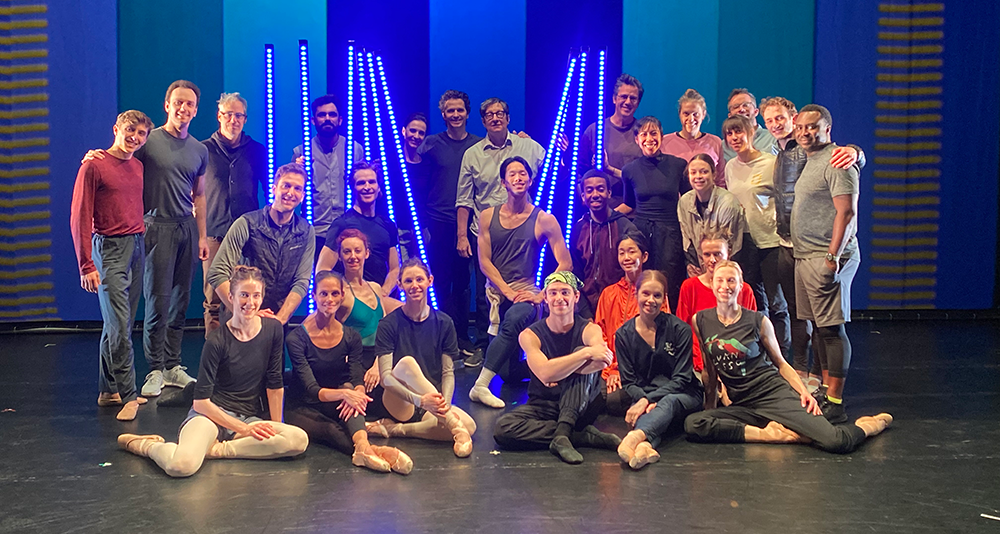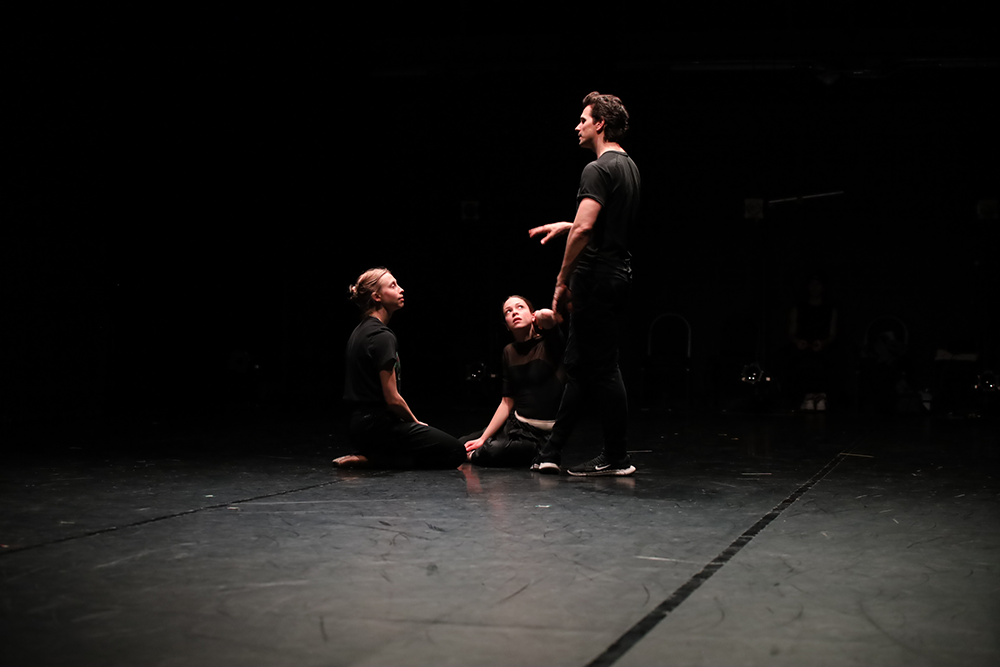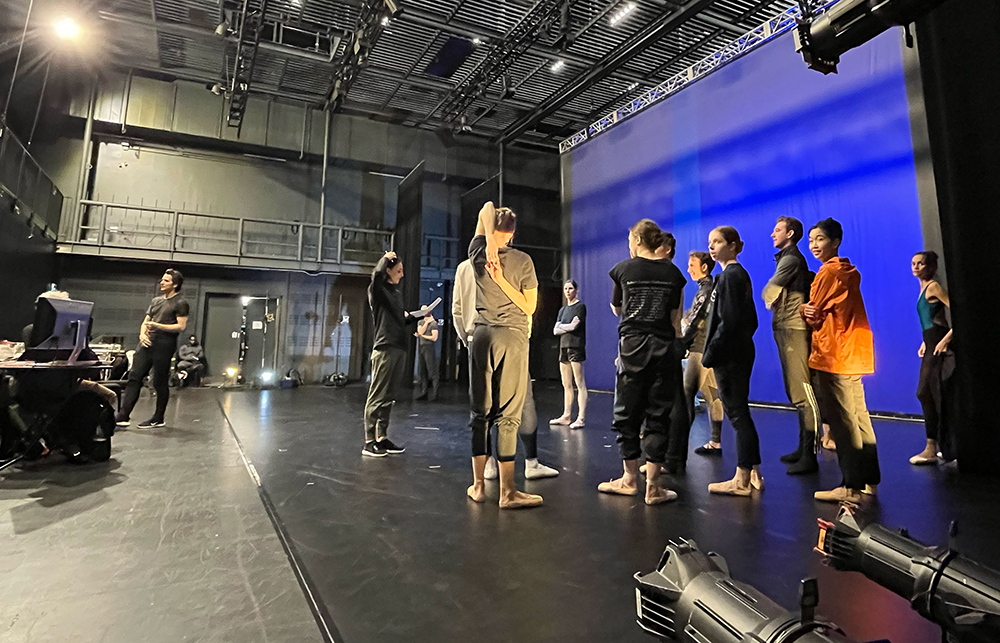Ballet
News+
Norman McLaren, Robert Lepage and Guillaume Côté:
The Art of Frame by Frame
by Caroline Dickie
May 2, 2023

Artists of the Ballet and members of the Frame by Frame creative team at Ex Machina. Photo by François Latulippe.
There is a lovely symmetry to Frame by Frame, in which the innovations of the production reflect and reveal those of its subject in Scottish-Canadian filmmaker Norman McLaren. McLaren was fascinated by dance throughout his career and made several dance films; but even without that overt connection he is a dancer’s kindred spirit – movement was his milieu. An animator, McLaren made static images dance, brought ordinary objects to life, and even composed original music by painting directly on film. His work is surprisingly human. Even his most abstract films are full of personality and joy.
Little wonder that theatre legend Robert Lepage, a dazzling technician in his own right, partnered with fellow Québécois artist Guillaume Côté to tell McLaren’s story frame by frame, in discrete yet connected vignettes. Lepage is a pioneering director of contemporary theatre, forever pushing the boundary of the new. So sophisticated is his use of stagecraft that the technical tricks disappear within a broader theatrical experience; there is more mystery than method in a Lepage production. A collaboration with The National Ballet of Canada had been discussed for many years, but it was in Norman McLaren that Lepage finally found his subject and, in Côté, an ideal partner.
The testing ground for Lepage’s creative imagination is Ex Machina, his state-of-the-art company in Québec City where he and his team devise moving sets, video projections, puppetry, and other wondrous methods for artmaking. Ex Machina was a creative hub for the development of Frame by Frame in 2018, with the dancers joining Lepage, Côté and the technical team in Québec City to workshop the show. As a kind of laboratory of dreams, Ex Machina resembles the animation department that Norman McLaren founded at The National Film Board of Canada, the first of its kind and a collaborative space for fellow animators like Evelyn Lambart and Grant Munro.

Calley Skanik, Jeannine Haller and Guillaume Côté in rehearsal for Frame by Frame. Photo by François Latulippe.
Ex Machina has been the site of an extensive revisiting process in the leadup to the National Ballet’s first restaging of Frame by Frame since the world premiere. Lepage has long pursued a “works in progress” approach, favouring experimentation and an openness to change even after a work has premiered. This is less common in ballet, where productions are more likely to be fixed in time until they are fully restaged.
With Frame by Frame, Lepage and Côté have allowed the work to evolve. Recently, they hosted another set of workshops in Québec City to revisit the choreography, storytelling and staging, taking the production from 21 scenes to 18 to focus more intently on dance. McLaren’s love for dance and his partner Guy Glover crystallize in Swan Lake – the first ballet McLaren attended, at Glover’s invitation. Lepage and Côté haven given that ballet a stronger throughline, so that it is now a recurring theme. Since many of the dancers are new to Frame by Frame this year – only three of the original cast members are performing – rehearsals have been less about about teaching choreography than recreating the show.
This organic approach suits Côté. He delights in the creative process, seeks out unique collaborations and prioritizes multidisciplinary work. As Principal Dancer and Choreographic Associate with the National Ballet, he has performed a vast repertoire and honed a distinct creative style that often sees him experimenting with movement and film. His popular dance shorts include Lost in Motion (2012) directed by Ben Shirinian, which uses a monochrome background and slow-motion sequences to highlight aspects of a solo performance he dances himself.

Artists of the Ballet in rehearsal for Frame by Frame. Photo by François Latulippe.
McLaren’s famous dance film Pas de Deux (1968) offers a different artistic experience to Lost in Motion but is similarly focused on accentuating the dancers’ movements through visual effects. McLaren backlit the dancers and used an optical printer to create strobe-like afterimages that, as in Lost in Motion, appear to slow things down. Ludmilla Chiriaeff, founder of Montréal’s Les Grands Ballets Canadiens, choreographed Pas de Deux for two Canadian dancers, Margaret Mercier and Vincent Warren. Côté took dance classes from both.
Frame by Frame recreates Pas de Deux on an enormous scale, projecting a live recording of two dancers performing Chiriaeff’s choreography on a scrim upstage, edited by Norman McLaren’s hand. This magical vision encapsulates the sympathetic talents of Côté, Lepage and McLaren and underscores the latter’s profound influence. Brilliantly, the technical complexity of Frame by Frame is always grounded in the fundamental story of artistic curiosity and human connection in McLaren’s life, making Lepage and Côté both heirs and custodians of his beautiful legacy.